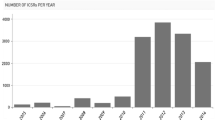Abstract
The current system of pharmacovigilance encourages reporting of adverse drug reactions (ADRs) mainly from healthcare professionals. Underreporting is a major problem, more so in the developing world than in the developed world. Less than 3% of reports added to the WHO database in the year 2000 originated from developed countries, although around 80% of the global population lives in the developing world. Also a considerable time lag still exists in recognition of serious ADRs. Hence, there is a need for a different approach to pharmacovigilance.
We present an overview of possible reasons for underreporting by healthcare professionals with particular emphasis on the developing world, and the potential benefits of encouraging consumer reporting. Only a few countries accept consumer reports. We suggest an independent consumer reporting system for hypothesis generation to complement the present health professional-based system. We also highlight the low priority given by multinational pharmaceutical companies to the developing countries regarding new safety information.
The important questions are whether the resources available would be sufficiently robust to sustain such a system in the developing world, and whether it will be sufficiently robust and sensitive for the early detection of signals.
Similar content being viewed by others
References
The First International Conference on Consumer Reports 2000 Sigtuna. Consumer reporting of adverse drugs reactions. WHO Drug Information 2000; 14 (4): 211–5
Edwards IR, editor. Pharmacovigilance - beyond 2000: opinion and evidence drug safety 2nd ed. Auckland: Adis International Ltd, 2000
Lazarou J, Pomeranz BH, Corey PN. Incidence of adverse drug reactions in hospitalized patients; a meta-analysis of prospective studies. JAMA 1998 Apr; 279(15): 1200–5
Friedman MA, Woodcock J, Lumpkin MM, et al. The safety of newly approved medicines: do recent market removals mean there is a problem? JAMA 1999 May; 281(18): 1728–34
Under reporting of adverse drug reactions: attitudes of Irish doctors. Ir J Med Sci 1999; 168 (4): 257–61
Backstrom M, Mjorndal T, Dahlqvist R, et al. Attitudes to reporting adverse drug reactions in northern Sweden. Eur J Clin Pharmacol 2000 Dec; 56(9-10): 729–32
Smith CC, Bennet PM, Pearce HM, et al. Adverse drug reactions in a hospital general medical unit meriting notification to the Committee on Safety of Medicines. Br J Clin Pharmacol 1996 Oct; 42(4): 423–9
Martin RM. Kapoor VK, Wilton LV, et al. Under-reporting of suspected adverse drug reactions to newly marketed (black triangle) drugs in general practice: observational study. BMJ 1998 Jul; 317: 119–20
Drug safety reporting in clinical trials. Reactions Weekly 2001; 851: 2–3
Uppsala Monitoring Centre. Reporting 2000 to the WHO programme, 2001. (Data on file)
Thomas M. Post-marketing surveillance problems and possible solutions in developing countries. Pharm Med 1993; 7: 267–71
Meyboom RHB, Egberts AGC, Edwards IR, et al. Principles of signal detection in Pharmacovigilance. Drug Saf 1997 Jun; 16(6): 355–65
Gonzalez CH, Dias MMJ, Kim GA, et al. Congenital abnormalities in Brazilian children associated with misoprostol misuse in first trimester of pregnancy. Lancet 1998; 351: 1624–7
Wang PS, Bohn RI, Glynn RJ, et al. Hazardous benzodiazepine regimes in the elderly; effects of half life, dosage and duration on risk of hip fracture. Am J Psychiatry 2001; 158: 892–8
World Health Organisation Drug Information 2002; 16 (1): 8–11
Ministry of Health. Annual health bulletin 1998. Sri Lanka: Ministry of Health, 72
Hartingan-Go K. Pharmacovigilance and the pursuit of rational drug use: the Philippines experience. Uppsala Reports 2001 Suppl. 14 Apr 2001
Drug Evaluation subcommittee. Alert about intramuscular diclofenac. Sri Lanka: Prescriber, 1998: 6 (1) 6
Mansfield P. Adverse Drug reactions Reporting by patients [online]. Available from URL: http://www.healthnet.org/programs/e-drug 1998 [Accessed 2002 May 30 ]
Edwards IR. Who cares about pharmacovigilance? Eur J Clin Pharmacol 1997; 53: 83–8
Egberts TCG, Smulders M, de Koning FHP, et al. Can adverse drug reactions be detected earlier? A comparison of reports by patients and professionals. BMJ 1996 Aug; 315: 530–1
Mitchell AS, Henry DA, Sanson-Fisher R, et al. Patients as a direct source of information on adverse drug reactions. BMJ 1988; 297: 891–3
Mitchell AS, Henry DA, Hennrikus D, et al. Adverse drug reactions: can consumers provide early warnings? Pharmacoepidemiol Drug Saf 1994; 3: 257–64
Alvarez RA, Cavajal A. Begaud B, et al. Under-reporting of adverse drug reactions, estimate based on a spontaneous reporting scheme and a sentinal system. Eur J Clin Pharmacol 1998 Aug; 54(6): 483–8
Medawar C. The Antidepressant web. Int J Risk Safety Med 1997; 10: 75–126
Eisenberg DM, Kessler RD, Foster C, et al. Unconventional medicine in the United States: prevalence costs and patterns of use. N Engl J Med 1993; 328: 246–52
Meek C. Direct to consumer advertising (DTCA) of prescription medicines: first quarterly update. January to March 2002. DTCA Update Report, Quarter 1, 2002 [online]. Available from URL: http://www.rpsgb.org.uk/pdfs/dtcarev/0203.pdf [Accessed 2003 Feb 12]
Glass RM, Molter J, Hwang MY. Educating patients: one-year anniversary of the JAMA Patient Page [letter]. JAMA 1999 Apr; 281(16): 1544
Woodcock J. Understanding adverse drug reactions and medication errors: a speech delivered to the US senate Health Education and labour committee [online]. Available from URL: http://www.alsna.com/mederrors.html [Accessed 2001 May 3]
Acknowledgments
The authors have received no funding for the preparation of this manuscript nor do they have any conflicts of interest directly or indirectly relevant to the content of this manuscript.
Author information
Authors and Affiliations
Corresponding author
Rights and permissions
About this article
Cite this article
Fernandopulle, R.B., Weerasuriya, K. What Can Consumer Adverse Drug Reaction Reporting Add to Existing Health Professional-Based Systems?. Drug-Safety 26, 219–225 (2003). https://doi.org/10.2165/00002018-200326040-00002
Published:
Issue Date:
DOI: https://doi.org/10.2165/00002018-200326040-00002




